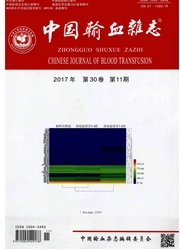

 中文摘要:
中文摘要:
目的 探讨开展HBV和HCV核酸检测条件下采供血机构筛查献血者ALT的意义。方法 对2010-2014年在广州血液中心献血后,经4项双试剂ELISA检测和ALT检测,仅单项ALT阳性的20 963名献血者的HBV/HCV核酸检测结果进行分析。采用分层随机抽样的方法抽取2012年在中心献血的上述献血者603名,对其进行间隔时间至少为半年的随访,每次随访均进行ALT、全项血清学ELISA检测及HIV、HBV和HCV NAT检测。结果20 963名单纯ALT阳性献血者经HBV/HCV/HIV核酸鉴别试验检出5例HBV DNA阳性,检出率为0.2‰;分别按性别、年龄和献血时间比较其ALT不合格率,组间差异均有统计学意义(P〈0.05);603名单项ALT阳性献血者经随访未发现有献血者出现除ALT外其他检测项目呈反应性。结论 在已经开展HBV及HCV NAT检测的地区,可以考虑取消对献血者进行ALT检测。对于尚未开展HCV或HBV NAT检测的地区,不宜简单取消献血者ALT的检测。
 英文摘要:
英文摘要:
Objective To discuss the significance of ALT screening in volunteer blood donors under the condition of performing HBV / HCV nucleic acid testing. Methods Of all the donors who donated blood during 2010 and 2014 in Guangzhou Blood Center and underwent ELISA and ALT screening, 20,963 donors who were positive by ALT were analyzed by HBV/HCV NAT. A six-month follow-up was performed to monitor 603 randomly selected ALT positive donors in 2012. Every visit during the follow-up, ALT screening, HBsAg, anti-HCV, anti-HIV and and-TP tests by ELISA and HIV/HBV/HCV NAT were conducted on these donors. Results Of 20,963 blood donors determined positive by ALT, only 5 blood donors were proved to be infected with HBV detected by NAT, at a rate of O. 2%. A comparison was conducted on donors' reactivity rates by ALT donors based on gender, age and season of donation. These categories showed statistically significant differences (p 〈0. 001 ). Of all the 603 blood donors deemed positive by ALT, none of them were proved to be reactive for HBV/ HCV infection by other tests. Conclusion In those districts where HBV / HCV nucleic acid testing is performed, ALT screening in blood donors should be considered eliminated. However in those districts where HBV/HCV NAT is not performed, ALT test should not simply be canceled.
 同期刊论文项目
同期刊论文项目
 同项目期刊论文
同项目期刊论文
 期刊信息
期刊信息
